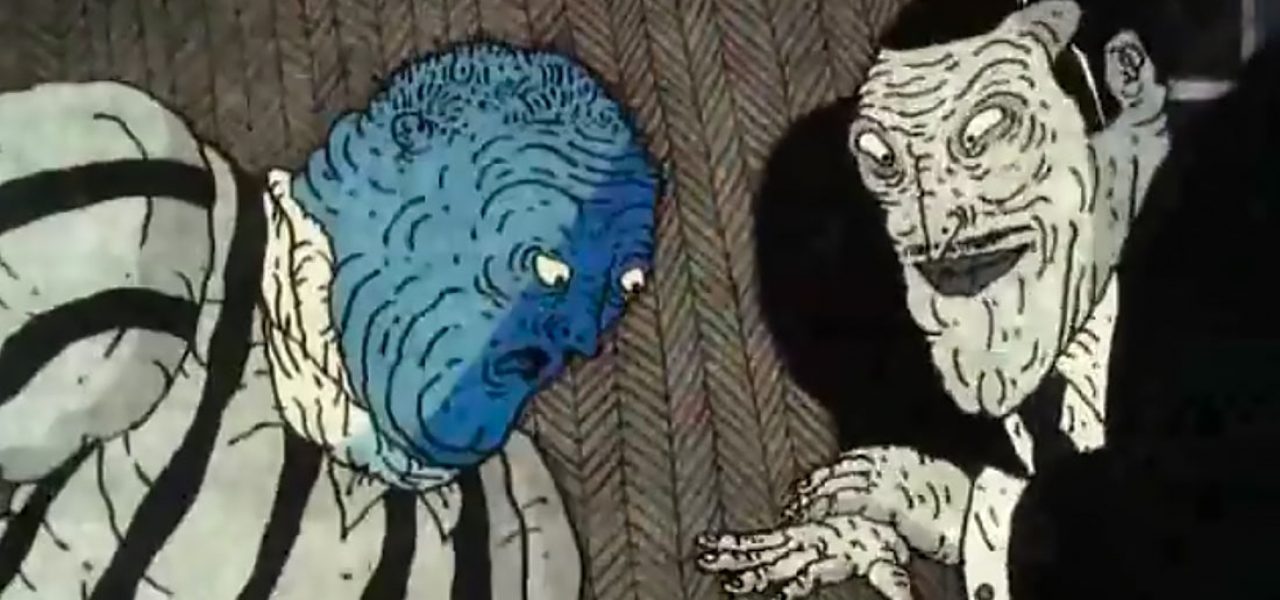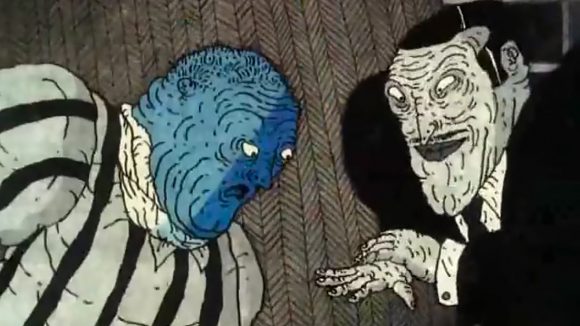

Ottawa Animation Festival 40th Anniversary Look-Back: ‘Hen, His Wife’
The Ottawa International Animation Festival, North America’s largest and most significant animation event, celebrates its 40th anniversary this year.
In honor of that occasion, the festival has commissioned a number of international animation historians, programmers and critics to write essays about each of its grand prize-winning films. In partnership with the festival, Cartoon Brew will present one essay per week leading up to the festival on September 21-25, 2016. Last week, we started with a look at the 1998 winner The Man Who Planted Trees. Today, we continue with the 1990 winner, Hen, His Wife, directed by Igor Kovalyov.
For more information on attending Ottawa, visit animationfestival.ca.
Ottawa 90 Winner: Hen, His Wife
Essay by Linda Simensky
A man, his wife, and their pet are living what appears to be relatively tranquil domestic life. Upon further examination, we are not quite sure if all is well. Things are starting to break. The “tranquil domestic life” part of this family scene seems a little off. The wife is a giant hen, for starters. The pet is a centipede/slug with a human head. The man is blue and lumpy. Everyone seems a little nervous about something.
As well they should be. A visitor shows up, and reacts with surprise that the wife is a hen. He marches through the apartment, and whispers to the man. The man seems surprised to find out his wife is indeed a hen. Perhaps he hadn’t noticed this? Perhaps he felt everything up until this point was good enough.
The stranger leaves. The man, clearly troubled by this news, enters a dream state and perhaps reconsiders his life. The hen leaves. Things don’t improve, and the man is now clearly lonely.
The hen returns to the apartment. To her shock, the man now has the same chicken feet that she has. That’s not what she wanted, and she’s gone again.
Perhaps the film was to be a reminder that everything might be fine with your life until someone shows up and tells you it’s not. And then it all falls apart.
In 1990, I was deep into writing my master’s thesis on independent animated shorts, and I was looking at the animation of four countries including Russia, which at the time was still part of the Soviet Union. I had watched enough Russian films to know that most Eastern European films were funded by the state, and therefore, virtually every Russian film needed to be an allegory of some sort to make its point. I remember assuming that Hen, His Wife must have been a political film with a much deeper meaning. I waited for a simple explanation of the story. None was forthcoming.
When I first saw this film, I was relatively new to the animation industry, and was developing the earliest animated series at Nickelodeon. My goal was to make Nickelodeon the crossroads between Looney Tunes and independent shorts. I had started to look at every film in terms of its development potential: is this film a cartoon, is it funny, and could this director create a show for Nickelodeon?
Hen, His Wife stumped me. It was clearly an “important film,” an absurdist parable. But without understanding the deeper meaning, all I could think about was how graphically detailed and cartoony the film was. This film was not a dreamlike 20 minutes of paint-on-glass film we were accustomed to from Russia. This film was surrealist Priit Pärn crossed with Yellow Submarine. The visuals and timing made me think we were watching a funny cartoon. The elusive story and the palpable level of angst made it clear it was something else entirely.
Some of the movement in Hen, His Wife was fast and cartoony, and the timing was clearly deliberate and occasionally accelerated like a typical cartoon. The graphic style gave everything black outlines. Objects would slide or disappear or move without help from the characters, the visitor could stomp over a table instead of around it, and a recording was played with a windup bus. I remember at the time getting caught up in simply trying to figure out if this film was funny or not. Or exactly what the theme of the story was. Domestic life falling apart wasn’t funny. So if a film looks funny and moves like a cartoon but isn’t funny, what does one make of that?

Around this time, Rugrats had been chosen by Nickelodeon to go to series. Gabor Csupo of Klasky Csupo, one of the creator/producers of Rugrats, clearly was inspired by the cartoon-like qualities of Hen, His Wife, as well. Csupo invited Kovalyov to come work at Klasky Csupo. Not long after Kovalyov finished his next film, Andrei Svislotsky, Kovalyov moved from Moscow to Los Angeles to direct Rugrats and then help create the series, Aaahh!!! Real Monsters. He then co-directed The Rugrats Movie in 1998.
Hen, His Wife helped introduce Moscow’s acclaimed Pilot Studio, of which Kovalyov was a co-founder, to the animation-viewing crowd. As the times were starting to change in Eastern Europe, Pilot was one of the first animation studios that was not a state-run studio, and not all the films coming out of Pilot were serious or overtly political. This was a game changer in the world of Russian animated film.
Hen, His Wife winning the Grand Prize at Ottawa in 1990 may have confused some at the time. After all, Nick Park had Creature Comforts and A Grand Day Out in the competition. My personal favorite that year was the film Exit from Sweden’s Filmtecknarna. That’s not a film that ever gained notice again, although Filmtecknarna would go on to great acclaim with other films.
Kovalyov and Hen, His Wife, on the other hand, went on to have enormous impact. The film no doubt helped to change our impression of Russian animated film. Perhaps it had impact in Russia, as well? Certainly, Klasky Csupo, Rugrats, and Aaahh!!! Real Monsters brought a new aesthetic to American cartoons. Soon the Russian film industry would no longer be state run. If the winning films at Ottawa were chosen with a sense of potential impact, Hen, His Wife was a prescient choice.

A few years later, I was set to speak at an event at the BFI about the early years of Nickelodeon animation, and I was asked to screen my favorite short films that had influenced me. Then a special request came from the person running the screening. Could I put Hen, His Wife on my list? The BFI had just purchased the film and wanted an excuse to screen it. Also, could I speak about why it was one of my favorite films, and how this film had influenced me? And with that request, the film was promoted to my top ten animated films list.
My proximity to Kovalyov through Nickelodeon led to some interesting conversations, but never any further explanations of his films. But that was probably okay, since I can still watch the film 25 years later and enjoy pondering it without knowing if I am closer to understanding it. Another reminder that some films can still be left open to interpretation.
Kovalyov continues to make short films. His most recent, Before Love, premiered at the 2016 Holland Animation Film Festival, winning the Grand Prix in the short narrative category. Apparently ambiguity is still alive and well at animation festivals.
